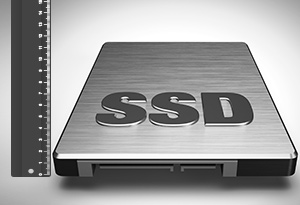My Size matters: Everything you need to know about SSD form factors blog in January spawned some interesting questions, a number of them on Z-height.
What is a Z-height anyway?
For a solid state drive (SSD), Z-height describes its thickness and is generally its smallest dimension. Z-height is a redundant term, since Z is a variable representing the height of an SSD. The Z is one of the variables — X, Y and Z, synonymous with length, width and height that describe the measurements of a 3-dimensional object. Ironically, no one says X-length or Y-width, but Z-height is widely used.
What’s the state of affairs with SSD Z-height?
The Z-height has typically been associated with the 2.5″ SSD form factor. As I covered in my January form factor blog, the initial dimensions of SSDs were modeled after hard disk drives (HDDs). The 2.5 HDD form factor featured various heights depending on the platter count — the more disks, the greater the capacity and the thicker the HDD. The first 2.5 full capacity HDDs had a maximum Z-height of 19mm, but quickly dropped to a 15mm maximum to enable full-capacity HDDs in thinner laptops. By the time SSDs hit high-volume market acceptance, the dimensional requirements for storage had shrunk even more, to a maximum height of 12.5mm in the 2.5 form factor. Today, the Z-height of most 2.5″ SSDs generally ranges from 5.0mm to 9.5mm.
With printed circuit board (PCB) form factor SSDs — those with no outer case — the Z-height is defined by the thickness of the board and its components, which can be 3mm or less. Some laptops have unique shape or height restrictions for the SSD space allocation. For example, the MacBook Airs ultra-thin profile requires some of the thinnest SSDs produced.
A new standard in SSD thickness
The platter count of an HDD determines its Z-height. In contrast, an SSDs Z-height is generally the same regardless of capacity. The proportion of SSD form factors deployed in systems is shifting from the traditional, encased SSDs to the new bare PCB SSDs. As SSDs drift away from the older form factors with different heights, consumers and OEM system designers will no longer need to consider Z-height because the thickness of most bare PCB SSDs will be standard.








Leave A Comment